Carrie Coon, right, plays nouveau-riche Bertha Russell in “The Gilded Age.” To her left is Taissa Farmiga, who plays Gladys, her young daughter. Russell’s dresses and gowns are more fashion-forward and in brighter colors than those worn by the old-guard women. / Photo here and on the front courtesy Alison Cohen Rosa/HBO.
By Nancy McKeon
THERE’S AN argument to be made for watching the new HBO series The Gilded Age with the sound off. That way you won’t be distracted by the hackneyed plot, the dismal dialogue, the caricatures that substitute for characters, and the “acting.”
Without the sound on, you can concentrate on the clothes.
There may be those who know nothing about New York’s Gilded Age, the post–Civil War period when immense fortunes were made in railroads and other burgeoning industries, and the old guard of polite society was forced to cede ground, slowly and resentfully, to the new monied crowd that was elbowing its way into stodgy drawing rooms up and down Manhattan’s broad avenues. For them, the show could be a tutorial, a kind of “Edith Wharton and Henry James for Dummies.”
For the rest of us, there are the 5,000 (plus or minus) gowns and tea dresses and capes and walking suits that depict an era when women were not so much clad as . . . upholstered.
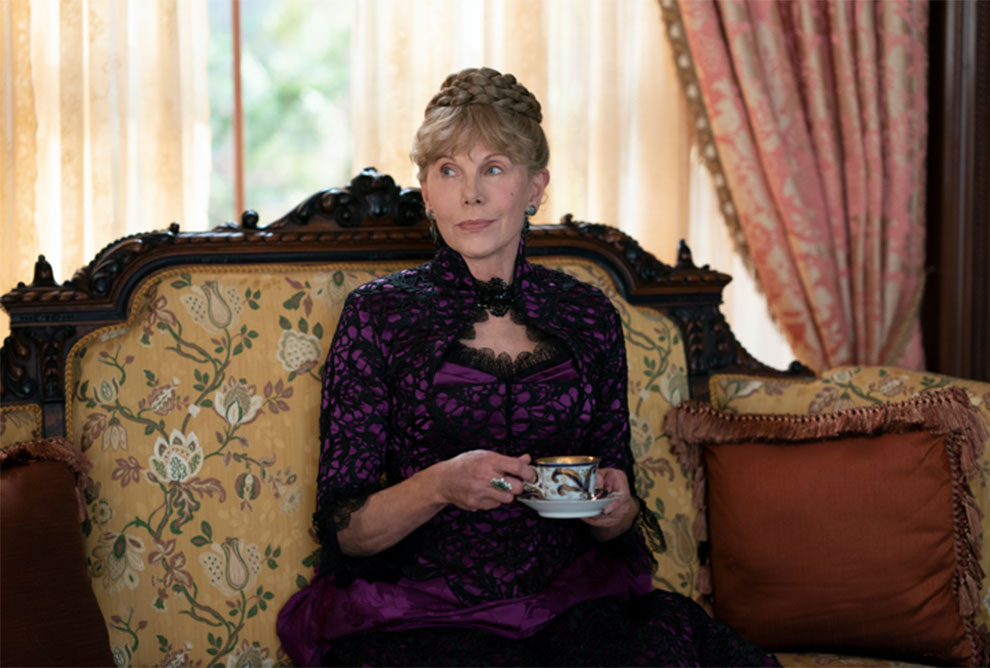
Christine Baranski, as Agnes Van Rhijn, dresses like the dowager she is, in dark colors, with intricate ornamentation. The one odd note in this parlor scene is the fabric on the loveseat. That’s the kind of chintz print one might use today to reupholster an old Victorian piece, to brighten it and allow its curves to stand out sculpturally. Much more likely, for Agnes, would have been a dark, perhaps plum or maroon, silk brocade. Or horsehair! Never forget horsehair! / Photo courtesy Alison Cohen Rosa/HBO.
Behind the creations is costume designer Kasia Walicka-Maimone and her team. That team was busy! As writer Alexis Nedd notes on Mashable, the parvenue Bertha Russell, played by Carrie Coon, has seven costume changes in the first episode, which is the only one I’ve seen so far. “Is seven the baseline?” Nedd asks. “Will next week have eight? Let’s definitely make it a drinking game.”
I’ll drink to that. The plot lines and dialogue in The Gilded Age are anything but nuanced, but that can’t really be said about the clothing.
The older “established” society ladies, most of them not that young, are often dressed in dark jewel tones, frequently adorned with symmetrical swags of lace or passementerie. But symmetry and dark jewel tones are not things Bertha aspires to: Her wardrobe crackles with color and energy. Not being a fashion historian, I don’t know how unusual it would be to lay a fluffy bodice insert on the diagonal, in a way echoing the tail feathers of the stuffed birds that sometimes pass for Bertha’s hats. Let’s just say those touches would not look out of place at a gala today (if anyone could go to a gala today).
A whole other look is given to Marian Brook, played by Louisa Jacobson*, the young penniless niece who has come to live with Agnes Van Rhijn (Christine Baranski), holder of the remnants of the family fortune thanks to a fortunate-unfortunate marriage, and she who will not be disobeyed. Cowering in the corner is Cynthia Nixon, fresh from her lesbian awakening on And Just Like That and now playing Agnes’s mouselike spinster sister, Ada Brook. Both of them dress on the dark side. Marian, on the other hand, gets the pastels that echo her youth and that place her outside the two competing social camps.
The Van Rhijn sisters simmer (well, it’s really only Agnes who’s close to being on the boil) in their brownstone, with its small dark and draped parlor, kitted out with brooding carved-mahogany furniture, while the Russells across the street strut their stuff in light, high-ceilinged splendor, complete with pale paneled walls, chandeliers and gilded boiserie.
Costumer Walicka-Maimone notes that in dressing her characters, she always follows the silhouette of the day; it would not do to violate the silhouette, which was still being broadcast from Paris and adapted by local dressmakers. But within the silhouette, she says, she felt free to adapt to suit the various roles the women play.
(About those local dressmakers: One of the first things Agnes Van Rhijn instructs young Marian to do is to go to her dressmaker to get some appropriate outfits. This may sound like something only a wealthy woman would do, but in fact there really was no ready-to-wear for women in 1882, the setting for the show. Men’s ready-to-wear, of a sort, did exist, largely having been born out of the need for general sizes of uniforms during the Civil War. So a woman of just about any station in that period would have had to sew something herself or find a local dressmaker. In the case of old-money Agnes, though, it would not have surprised me if she had asked a maid to go through her old dresses and rejigger something for her young niece. You know, the old-money response to fashion trends: “But I already have a dress!”)
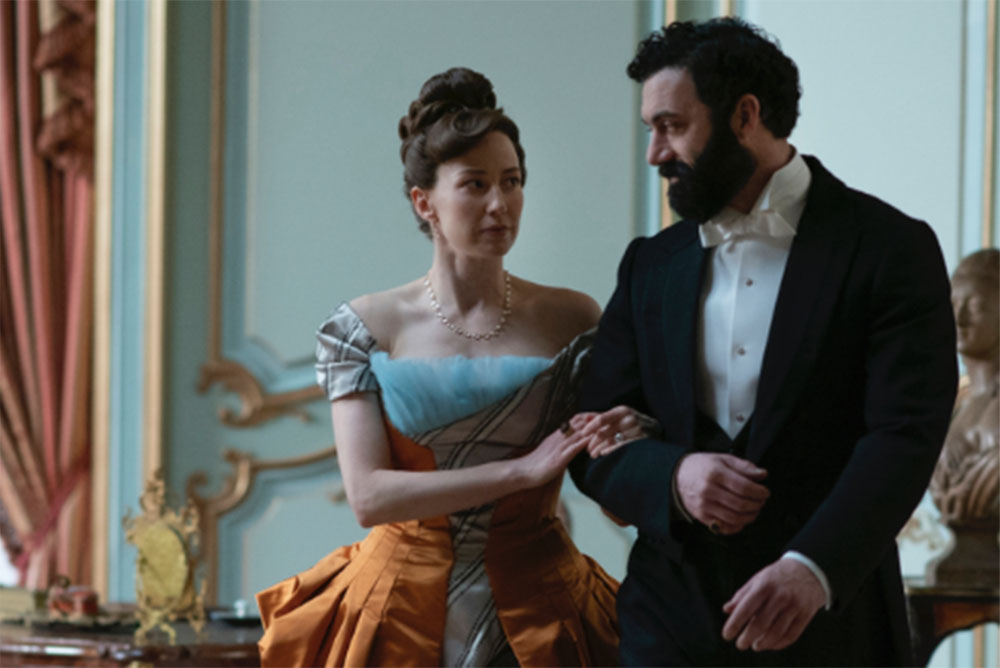
Brash Bertha Russell and tycoon husband George, played by Morgan Spector. One could imagine that gown getting good marks on the Oscars’ red carpet, no? / Photo courtesy Alison Cohen Rosa/HBO.
So the clothes in The Gilded Age have a language of their own, and, with a little practice, all of us can understand it. Even with the sound off.
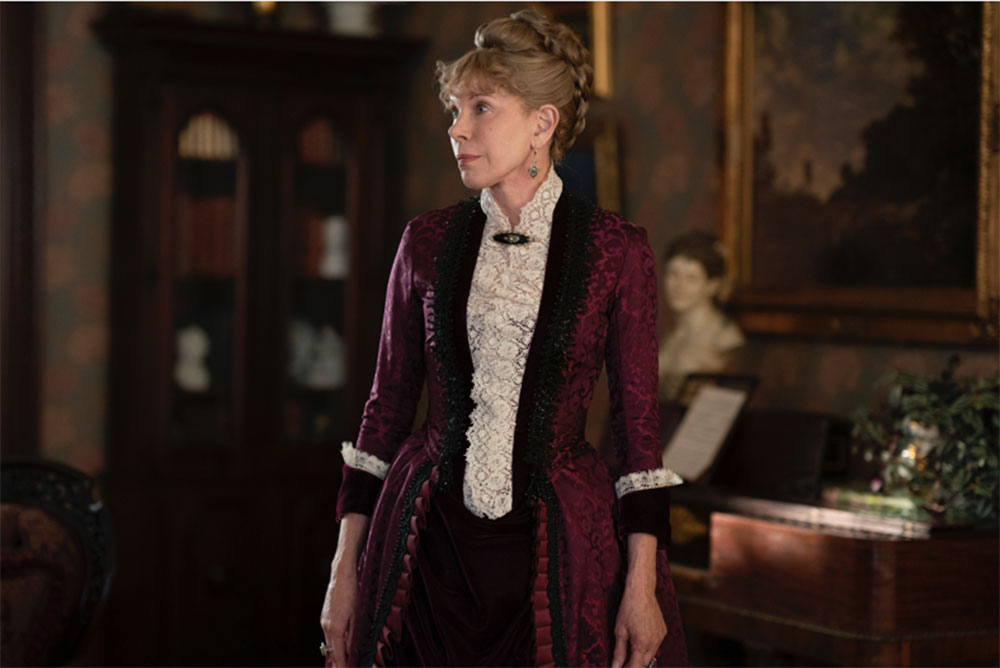
Poor Agnes Van Rhijn (Christine Baranski). Her somewhat somber at-home dress blends into the somewhat drab surroundings, while . . . / Photo courtesy Alison Cohen Rosa/HBO.
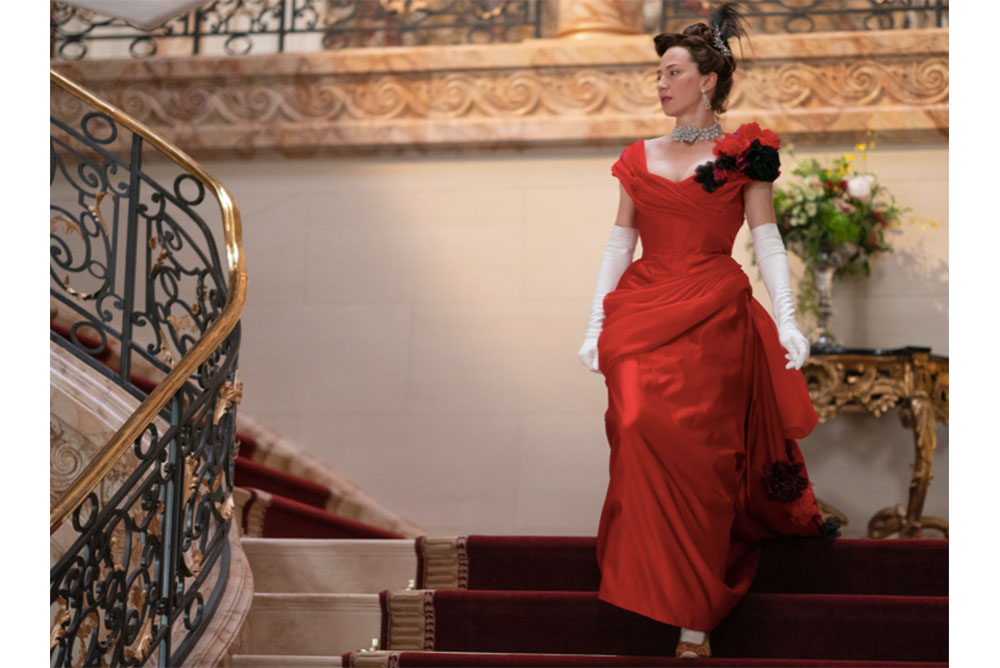
. . . firecracker Bertha Russell (Carrie Coon) is determined to blaze her way into the society that is intent on ignoring her. Even in that dress. / Photo courtesy Alison Cohen Rosa/HBO.
*It is apparently required by the gods of entertainment journalism that it be pointed out that Louisa Jacobson is Meryl Streep’s daughter. Done.

Oooh I need to watch
A good escape to another era.
Wow, I just learned a lot about gilded age retail (or lack of it)!
Not so much clad as upholstered. Love that, Nancy.
I’m just hoping I made that line up and didn’t steal it!
Yes! Addicted to the clothes.